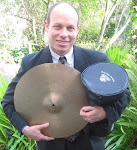I have used this short skit successfully in World History (in the study of the industrial revolution), and American Government and Economics. Feel free to copy and use it, and please let me know how the lesson went. The teacher may wish to prepare a short presentation comparing laissez-faire capitalism to Marxism and examine the vocabulary words (below) before doing the skit. The teacher may do the skit alone or have students perform it. Enjoy!
- Mike
Mike Spinrad, San Marin High School, Novato, California
Karl Marx Encounters
Capitalist
Scene: London
1850
Marx: My backside hurts from boils, probably
because I’ve already sat and read in the public library for six hours today.
Who’s coming to greet me?
William
Pound: It’s
me, William Pound.
Marx: Ah yes. Pound, I called
you to discuss your ridiculous beliefs about factory owners. Why don’t you
understand that every time a factory produces something, workers are exploited?
William
Pound: The
workers trade their labor for pay. It’s a free exchange where both owner and
worker agree, without coercion, to engage in a contract. What could be wrong
with that?
Marx: The workers are paid
poorly and working conditions are bad. The workers are nothing more than
slaves, wage slaves.
William
Pound:
Working conditions have been improving for years, thanks to recent laws passed
by Parliament and the power of unions. Additionally, not all factory owners
treat their employees poorly. Don’t you
think a worker has mastery over his own fate and can move, working wherever he
pleases?
Marx: I am a determinist. I do
not believe in free will. It’s an economic system, not individuals that
determine history. As it has been said, the system makes people act the way
they do.
William
Pound: What
nonsense are you saying? An economic system produced the ambition of Napoleon
and genius of the Duke of Wellington? People, not systems make choices in their
lives and create history.
Marx: You sound like my Jewish
grandfather. He thought that people have choices too. I’m glad I was baptized
as a young child and that you’re not Jewish.
William
Pound:
Karl, you’re a vicious anti-Semite as well as the originator of catchy but
superficial ideas. Naturally, no one wants to be against workers earning a good
living. Few common people care about liberty, however, until it’s gone. Just
how do you propose the change to socialism will occur?
Marx: I believe that the
capitalist system will destroy itself by producing enough disgruntled workers.
These workers will take over and replace capitalism with a socialist paradise.
We won’t need liberty in this socialist paradise.
________________________________________________________
Name
______________________
Define the following words
and answer the questions:
Liberty
Determinist
Exploited
Anti-Semite
Coercion
_____________________________________________________________
What
is more important to you, liberty or equality of outcome? Why?
Do
you believe in determinism or free will?
Why?









